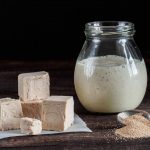Dried Yeast
Dried yeast comes in small granules that need to be rehydrated before use.

Dried yeast is simply fresh yeast that has been dried and pressed into a powder or flakes, this process makes the yeast inactive and it remains dormant until you rehydrate it. Once hydrated, yeast starts to produce carbon dioxide, this is what makes bread rise. Dried yeast used in all kinds of baking form focaccia to pizza dough.
Dried yeast widely available, and can be bought in most supermarkets. Yeast is naturally gluten-free, but it is important to check the packet as the manufacturing process can change that.
Using dried yeast
Before you can use dried yeast in your recipe you have to rehydrate it.
- Add the sachet to a bowl
- Pour in warm water with some sugar.
- Stir until the yeast granules are completely dissolved.
- Set aside for 5 to 10 minutes, in this time the mixture should have foamed.
Dried yeast and fresh yeast

The difference between dried and fresh yeast is simple: Fresh yeast is sold in solid cubes or blocks, and dried yeast is a powder usually sold in jars and sachets.
It is a good alternative for fresh yeast mainly because it has a much longer shelf life (usually about 2 years) and it’s easier to store. Unopened it can be stored at room temperature and it doesn’t need to be refrigerated. Once opened leftover dried yeast should be kept in a cool, dark, dry place.
If you want to use dried yeast instead of fresh yeast you use half the quantity of fresh yeast in the recipe. For example, if the recipe calls for 10g of fresh yeast you can use 5g of dried yeast.
Dried yeast and instant yeast
Instant yeast has a finer texture and it doesn’t need proving. This means it can be mixed right into dry ingredients. While dried yeast has larger granules and it needs to be proved.
Yeast to flour ratio
A good ratio to stick to is 7 grams of dried yeast to 500g of flour. You can use less dried yeast for a slower leavening.





